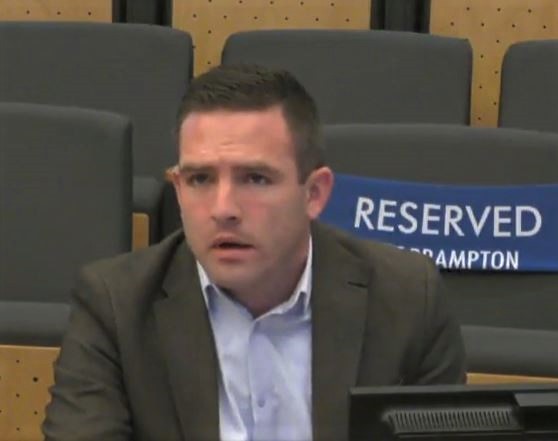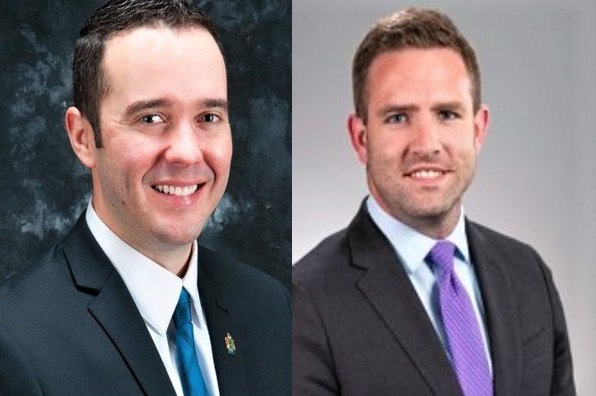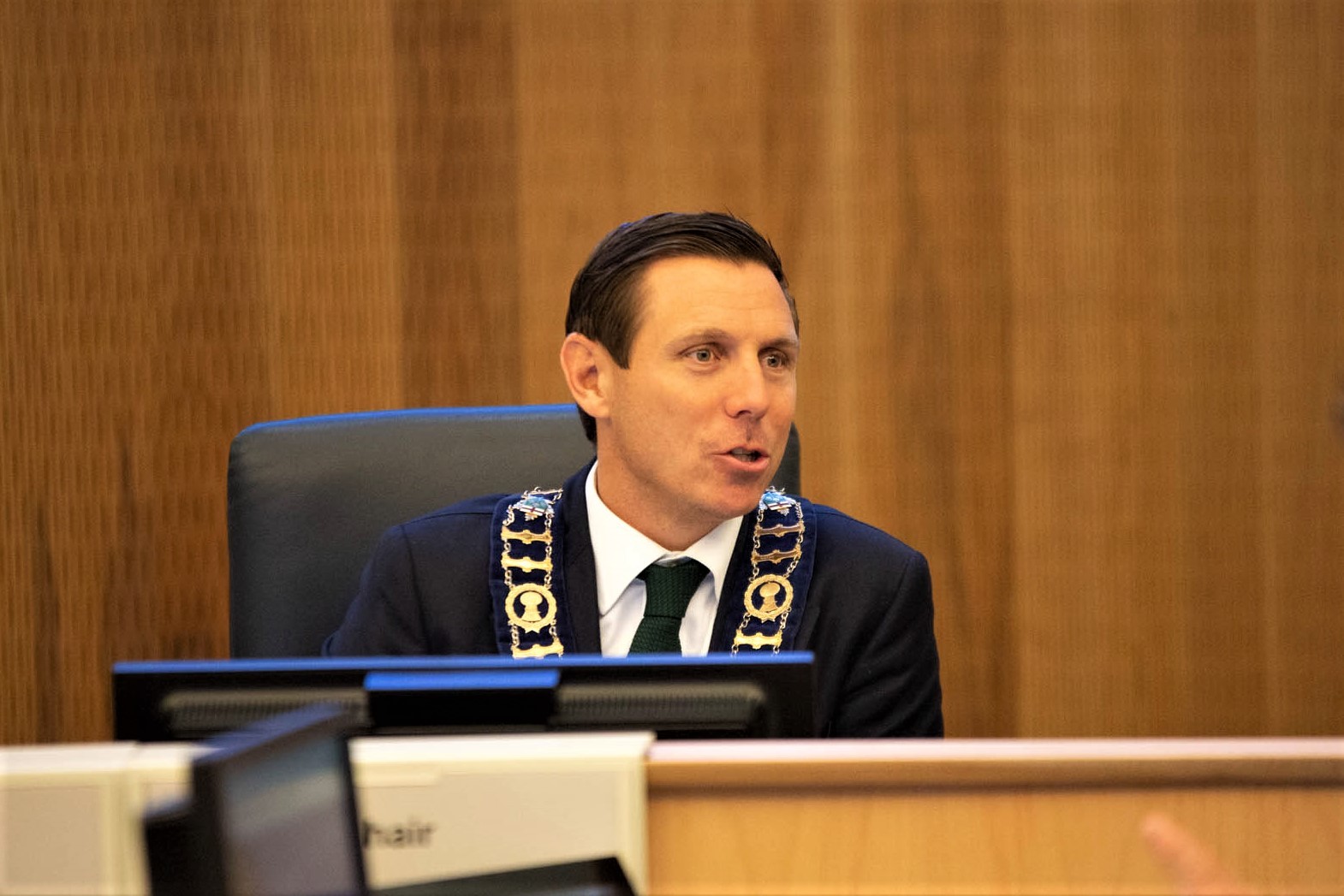
Jason Tamming, Brampton’s head of communications, makes misleading claims about his corrupt behaviour in Niagara scandal
Jason Tamming, the man inside Brampton City Hall responsible for transparent and accurate communication with the public, will not explain why he attempted to mislead residents, staff and council members through requests he sent to The Pointer attempting to downplay his corrupt behaviour while employed by Niagara Region.
The head of strategic communications was hired under the leadership of Mayor Patrick Brown after being fired from his communications job in Niagara following his behaviour in the rigged hiring process for its former CAO, Carmen D’Angelo.
On October 19, he made misleading written statements in an email sent directly from his own City of Brampton account at 10:15 p.m., just over an hour after The Pointer published an article that detailed his corrupt behaviour in Niagara, citing a damning investigation report into the matter by the Ontario Ombudsman, titled “Inside Job”. Tamming copied staff inside City Hall on the email, which claimed the article contained “elements, which are entirely false and misleading…”.
Tamming highlighted from the article the following line, which also mentions Brampton CAO David Barrick, who was also singled out by the Ombudsman for his role in the Niagara CAO hiring scandal: “... he secretly provided the candidate preferred by him and Barrick with the questions and answers ahead of the interview process – resulting in his firing”.
In his email to The Pointer demanding a correction, Tamming claimed:
“No questions were provided to any candidates in the recruitment process, except by the recruitment firm directly. The Ombudsman has never stated what you allege. The statement is false.”
The following is from the Ontario Ombudsman’s Inside Job report:
99 On Friday, October 7, 2016 at 12:51 p.m., the Director of Communications (Tamming) created a document saved as “Q&A,” which appears to answer the questions assigned to the CAO candidates. A list of suggestions at the top of the page is specific to Mr. D’Angelo’s experience at the conservation authority… the document is organized with the five assigned questions as headings...
100 Mr. D’Angelo’s downloads folder at the conservation authority... At 7:27 a.m., it was saved again, this time as “[Director of Communications’ initials] Q&A Suggestions.”
101 [Mr. D'Angelo] opened that document while reviewing the suggested answers sent by the Director of Communications.
102 Mr. D’Angelo told us he might have received the suggestions document from the Director of Communications.
135 The Chair’s Director of Communications (Tamming) provided information to help Mr. D’Angelo draft his written submission and presentation.
The Pointer asked Tamming why he attempted to mislead the public and City staff about his corrupt behaviour detailed in the Ontario Ombudsman’s investigation report.
He did not respond.
Tamming’s request went on.
He highlighted the following from The Pointer’s article: “Tamming misled the Ombudsman”.
He claimed: “This statement is false, and an editorial opinion, not fact. The interviews with the Ombudsman are confidential and I provided testimony that was accurate. The Ombudsman did not allege my testimony was false.”
The following is from the Ombudsman’s investigation report:
102 ... The Director of Communications (Tamming) told us that Mr. D’Angelo had his phone number and may have called to discuss the questions from the search firm. He told us that Mr. D’Angelo provided him with some proposed answers, and that the Director gave him “some insight to” those answers.
In response to Tamming’s claim that he did not mislead the Ombudsman, The Pointer stated, “You wrote out the questions and answers, tailored specifically for Mr. D'Angelo. These were provided to him in a document. You did not provide him with 'some insight' over the phone, you wrote out the questions and detailed, specific answers tailored for Mr. D'Angelo in a document that was given to him. You did not do this for any other candidate.”
Tamming did not respond.
Both Tamming and Barrick were hired into two of the most senior positions inside Brampton City Hall, Barrick as the top bureaucrat in charge of thousands of public-sector staff. They have direct links to Mayor Patrick Brown, who quietly orchestrated their hiring despite their involvement in the Niagara scandal, through the provincial and federal Conservative parties. They were both implicated in the damning investigation by Ontario Ombudsman Paul Dubé for their role in getting D’Angelo — Barrick’s boss at the local conservation authority at the time — hired.
Barrick is a former Port Colborne councillor who worked closely with a number of Niagara-area Conservative figures, including former MP Rick Dykstra, who served with Brown as a Conservative backbencher in Ottawa, and then became Ontario PC Party president while Brown was the leader. Tamming, prior to his career in municipal government, worked in Ottawa as a Conservative government staffer while Brown was a Conservative MP.
The City of Brampton, under Brown’s direction, spent $30,042.03 recruiting and hiring Barrick in October 2019 and $39,840.61 for the process to bring Tamming on in May 2019. Documents obtained by The Pointer through freedom of information show that Babu Nagalingam, Brown’s chief of staff, was included in all invoices regarding Barrick’s hiring.
Brampton taxpayers paid more than $182,000 for Tamming's salary and benefits and over $322,000 for Barrick's in 2020.
The Ontario Ombudsman’s Inside Job report, which chronicles actions by both Tamming and Barrick to get D’Angelo the CAO position, came on the heels of a citizen-led effort to expose what was happening. A dedicated group of Niagara residents filed FOI requests, mined public documents and involved the local media to expose what was happening in local government.
“The Regional Municipality of Niagara’s 2016 CAO hiring process was an inside job, tainted by the improper disclosure of confidential information to a candidate – a candidate who was ultimately successful and became the region’s most senior administrator,” Dubé’s report says. “Individual actions led to some of the wrongdoing I found during my investigation… I found that the regional municipality’s actions with respect to the CAO hiring process were unreasonable, unjust, and wrong.”

David Barrick (left) and Jason Tamming were both fired from their jobs in Niagara before Patrick Brown had them hired in Brampton.
(Images from Twitter/City of Brampton & LinkedIn)
Tamming was the man who sent D’Angelo the questions for the CAO interview process and helped write the answers provided to the man who was eventually given the job. In response to an interview question, for example, about ideas for economic development in Niagara, Tamming’s “Q&A” document advised D’Angelo to say a Bank of China branch should be pursued.
A long-standing practice inside the Ombudsman’s office makes it easier for Tamming, and others who may have tainted pasts, to deny them even in the face of the facts. The Inside Job report only uses D’Angelo’s name directly (others are identified by their title) because he held multiple roles during the events the report detailed.
Proving the director of communications referenced in the Ombudsman’s report is Tamming is as simple as searching his LinkedIn account or any number of local media articles that followed the unfolding scandal. But the fact Tamming’s name does not explicitly appear in the report is now an issue as he attempts to mislead Brampton staff and the public about his corrupt conduct.
In his report, the Ombudsman explains that it “should be understood” that the job titles used in the report “refer to the individuals who held them at the relevant times”. The Ombudsman also said it is not his practice “to name individuals in reports, whether they are complainants whose confidentiality must be protected … or public servants and other officials whose actions are the subject of our investigations.” That is “because our focus is on administrative conduct,” and not to “name blame and shame” individuals.
A spokesperson for the Ombudsman highlighted this portion of the report in response to questions from The Pointer about the practice of not naming those involved in wrongdoing inside local government.

Patrick Brown has wrongly said his handpicked CAO David Barrick is not implicated in the Inside Job investigation report.
(Photo The Pointer files)
Brown has also attempted to mislead the public, by making out his controversial hires are not tainted by their past.
“[The] ombudsman named people who committed wrong doing,” he wrote in a comment on the Facebook group Brampton Beats in 2020. “Our CAO was not one of them.”
The claim is blatantly false. D’Angelo is the only person named in the Ombudsman’s report, largely to avoid confusion because he held multiple roles during the events described.
Tamming’s office also tried to distance Brampton’s CAO from his involvement in the Niagara scandal. “CAO Barrick is not named or implicated in the Ontario Ombudsman Report, nor has the Ombudsman confirmed his involvement,” Tamming’s office wrote in an April correction request to The Pointer, following an article that detailed Barrick’s checkered past. The statement is demonstrably not true, according to the Ombudsman’s report and extensive local media reporting.
Barrick was a Niagara councillor at the time and also worked at the local conservation authority where D’Angelo was his boss.
The Ombudsman report details an interview with a former senior Niagara employee: “... a councillor (Barrick) reached out to him to arrange a meeting to discuss Mr. D’Angelo as a ‘successor.’ The employee told us it was clear to him that Mr. D’Angelo was the councillor’s choice for the position; he said the councillor assured him that he could ‘get the votes’ to complete the hire.”
Barrick told the Ombudsman he did not recall this exchange with the staffer. But Dubé had proof.
“We obtained an email from the councillor (Barrick) to the employee dated April 15, 2016, in which the councillor thanks the employee for the meeting, and suggests that the employee mention Mr. D’Angelo’s name to other staff as a good candidate for CAO.”
A December 2019 report in the St. Catharine’s Standard confirmed the April 15, 2016 email was sent by Barrick. He was the councillor referenced in the Ombudsman report and the email reveals that he promised the employee “influence” in exchange for help with the scheme to get D’Angelo hired.
After Tamming’s office sent The Pointer the claim that Barrick was not “implicated” in the Ombudsman report, the relevant passages from the Inside Job were sent to Tamming’s team, asking if Barrick denies he was the “councillor” referred to by the Ombudsman.
No response was received.
Tamming also tried to muddy the waters of Barrick’s past in a correction request his office sent in April. The claim said the Brampton CAO had not been fired from his previous role with the Niagara Peninsula Conservation Authority (NPCA) when he was in fact dismissed from his role. Barrick was fired on November 23, 2018, and then hired as NPCA’s CAO, following a change of leadership on December 6.
These efforts by Brampton’s head of communications, using the taxpayers’ money to deceive them about what he and Barrick did before Brown had them hired inside City Hall, raise concern about the decision to only use their job titles in the Ombudsman’s alarming investigation report.
The Ombudsman was asked if Tamming ever attempted to clarify his conduct at any point during the preparation and publication of the Inside Job report.
“In the interest of procedural fairness and accuracy – and, again, according to standard ombudsman best practices – a draft was provided to relevant officials for review and comment before the report was finalized and published,” Linda Williamson, director of communications for the Ombudsman, told The Pointer.
This suggests Tamming could have raised concerns about the report and its evidence when it was being written and didn’t. He is now trying to change the public’s understanding of the Ombudsman’s finding, after it was released.
Meanwhile, public funds that belong to Brampton taxpayers are being used by Barrick and Tamming to rewrite their dark history through the City’s communications office.
If residents have an issue with this, Williamson invited them to do something about it.
"Anyone who has a complaint regarding administrative issues in the Municipality of Brampton that are relevant to the Ombudsman’s jurisdiction is welcome to contact our office."
Email: [email protected]
Twitter: @isaaccallan
Tel: 647 561-4879
COVID-19 is impacting all Canadians. At a time when vital public information is needed by everyone, The Pointer has taken down our paywall on all stories relating to the pandemic and those of public interest to ensure every resident of Brampton and Mississauga has access to the facts. For those who are able, we encourage you to consider a subscription. This will help us report on important public interest issues the community needs to know about now more than ever. You can register for a 30-day free trial HERE. Thereafter, The Pointer will charge $10 a month and you can cancel any time right on the website. Thank you
Submit a correction about this story


